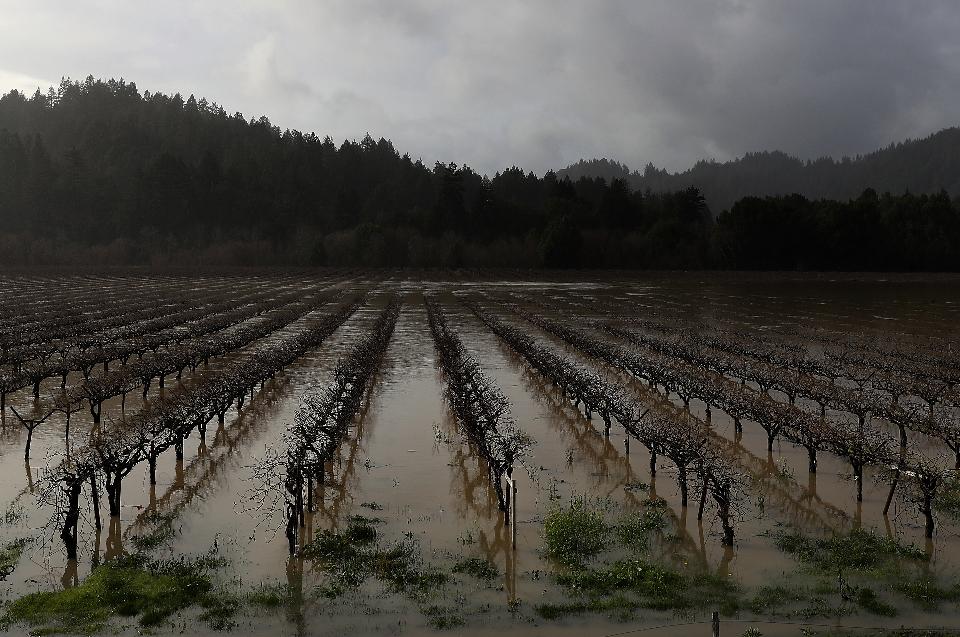
“Our dramatic hillsides were carved over millennia by rains just like these. Ironically, now that we have planted vineyards, we want nothing to change. But despite our best efforts, change is inevitable.”
—Chris Howell
“How This Wet, Wild Winter In California Wine Country Could Have Unexpected Benefit” Forbes, February 2017:
Unusual weather throughout much of the United States this winter has been the subject of speculation, consternation, and obsession across the country. Springlike heat in the Mid-Atlantic and flooding rains in the West have wreaked havoc across a wide range of industries. In the past two months, both the Napa River and the Russian River, the latter in Sonoma County, hit flood levels.
How, then, is this weather affecting the great wine regions of California? And what will the impact be for the 2017 vintage?
Fortunately, because of the natural cycles of vine growth and vineyard-management requirements, the floods don’t seem to have caused too much damage to the vineyards themselves—at least, nothing that can’t be fixed. “[Other] than physical damage to the trellising and needing to remove debris from vineyards which were flooded (including our own Westside Farms in the Russian River Valley),” there hasn’t been any damage to the vineyards of Ramey Wine Cellars, David Ramey noted in an email.
Christian Gastón Palmaz, of Palmaz Vineyards, also dodged the proverbial bullet. “Fortunately we haven’t experienced any significant damage,” he wrote in an email. “Because the rains were late enough in the season, our cover crops had sufficient time to stabilize soils and avoid top soil erosion of our steepest slopes.”
Not everyone was as lucky. Jeff Smith, Proprietor of Hourglass Wines, wrote to me that his “biggest issue is the damage caused by trees coming down. We’ve had several 150 foot digger pines come down that have taken out some vineyard rows. That’s a sight to see!”
Overall, it seems as if some soil erosion is possible, but if steps have been taken beforehand to mitigate that risk, many producers and growers remain in good shape. “At Cliff Lede Vineyards, we have extensive drainage and erosion control practices and procedures in place, therefore, we have not seen any damage or issues at our estate vineyards,” explained Remi Cohen, Vice President and GM. “Other vineyards in the area that have been flooded should be okay too, as long as the water drains before the growing season begins.”
Christopher Howell, Wine-Grower and GM at Cain Vineyard and Winery and one of the most incisive minds in the business, is taking the long view. “Our dramatic hillsides were carved over millennia by rains just like these,” he wrote in an email. “Ironically, now that we have planted vineyards, we want nothing to change. But despite our best efforts, change is inevitable. Our cover crop has worked perfectly to prevent runoff and erosion. Thanks to our attentive crew, the surface drains have worked very well. Even so, we have seen some movement, and a few slides, for the most part, not in the vineyard. Thankfully, our vines are intact.”
…
The next big moment in the vineyard that will impact the 2017 vintage is bud break, which may be slightly delayed this year as a result of the weather. But that’s not necessarily a bad thing. Christopher Howell, of Cain Vineyard and Winery, noted that, “Right now, we’re hoping for a somewhat later bud break (April) with adequate moisture in the soil—it should be a set up for [a] very healthy, happy growing season. If the flowering comes a bit later—in June—the weather is likely to be good, so there will be a reasonable harvest. So far, so good!”
By Brian Freedman

